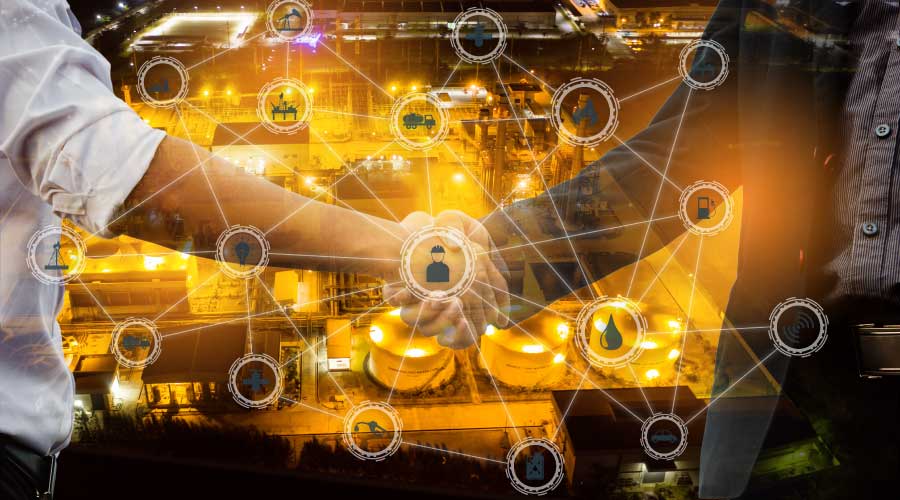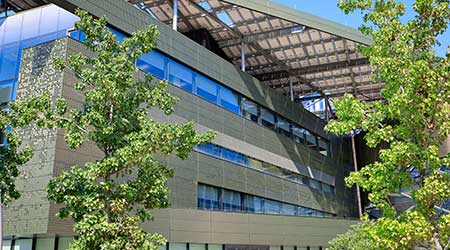Daylighting Strategies Lead to Savings
Sustainable lighting design can reduce energy costs while improving occupant satisfaction
Lighting does far more than illuminate the built environment. It also affects building occupants’ health, comfort and productivity, as well as their perception of a space. Lighting also consumes lots of energy: the U.S. Department of Energy estimates that lighting consumes one-fifth of the total electricity generated in the United States, and of that amount, the commercial sector uses a quarter. That translates into a significant slice of facility executives’ budget.
Most commercial spaces use fluorescent lamps as their standard source for illumination. However, estimates show that 30 to 50 percent of these spaces can integrate daylighting through windows or skylights. Integrating and managing daylighting with electric lighting can translate into significant energy savings.
With the current emphasis on health and productivity, sustainable design and its effects on building occupants is receiving much more attention than lighting design alone.
The visual performance of building occupants — that is, the ease with which they can perform a task — depends not only on the quantity of light, but also on the quality of lighting. These are the primary concerns of any lighting design. While quality is a subjective assessment, an occupant’s visual comfort is affected especially by factors such as the angle at which light is delivered, its uniformity across the surface, and the level of glare and veiling reflections.
Design for Visual Performance
To assure high visual performance within a space, it is essential to identify and properly address the hierarchy of illumination across vertical and horizontal surfaces, task versus non-task areas, and the human dimension. These criteria also extend to daylight integration. Entry and usability of daylight in the interior of a building have to be designed and managed. Three-dimensional computer simulations assist with development of architectural features that allow deep penetration of daylight, while eliminating or reducing direct light or sunlight penetration.
Once the orientation of the building and the architectural fenestration details are developed, daylight levels should be used to design electrical lighting and controls. The use of daylight not only serves as a sustainable source of illumination, it also has many benefits that relate directly to the occupants.
The Human Dimension
Research has shown that lighting provides cues to human beings as to time of day with positive effects on maintaining natural circadian rhythms or the natural sleep-wake cycle. While ongoing research is being conducted to verify the specific effect of all the variables, there is no doubt that lighting also has an effect on health. One study conducted by the Lighting Research Center showed that in a long-term care facility for Alzheimer’s patients, exposure to blue light-emitting diodes (LED) at a predetermined spectrum and quantity were instrumental in maintaining the patient’s sleep-wake cycle. The regularity of patients’ sleep cycles not only benefited the patients but also the staff.
Mixing daylight from skylights with electric lighting has been shown to affect retail sales in a few big box retail applications. Research has also indicated that daylighting can improve the performance of school children.
The conclusions of these and various other research projects suggest that lighting not only illuminates the environment but can have a significant impact on human health and performance.
Energy and the Environment
Current energy codes limit how much wattage can be consumed for most lighting applications. ASHRAE sets standards for lighting power density, or the maximum amount of wattage allowed per square foot of the building.
A byproduct of lighting is heat. Thus, lighting can significantly add to the cooling loads and affect the design of HVAC systems. The allowances for lighting power density are therefore becoming more stringent by the year, forcing the use of increasingly efficient lighting systems.
One of the first steps to addressing energy efficiency is to use the naturally available resource, daylighting. However, daylighting cannot be depended upon as the primary source of illumination. In most commercial designs, it is used to supplement electric lighting. To minimize the power density of the electric lighting system, start by using energy-efficient sources of illumination. Additional strategies include effective use of occupancy sensors and lighting controls, which are now required by code in most states.
The lamp and the luminaire are equally important because they are designed to work as a unit. A well-designed luminaire delivers most of the light from the lamp, while maintaining good cut-off angles to prevent glare.
Starting with the right lamp technology will improve lighting power densities. Because of their energy efficiency, fluorescent lamps are generally used in indoor spaces in commercial and institutional facilities. Other energy efficient technologies include light emitting diodes (LEDs), ceramic metal halides (CMH) and a few halogen sources. While halogens have an efficiency of 20 lumens per watt at best, linear fluorescents and CMH lamps have efficiencies between 60 and 85 lumens per watt.
Linear fluorescents and miniature CMH lamps are available in smaller diameters. Smaller lamps lend themselves well to efficient and aesthetically pleasing fixtures. Smaller lamps also allow various optical designs and multiple beam distributions. Low-wattage miniature CMH lamps are increasingly being used as accents, especially in retail applications, substituting for often used miniature halogen lamps. Additionally, all the light sources discussed above are available in multiple color temperatures. CMH lamps are available in 3,000-degree Kelvin, emitting light with a warm or yellowish tone, usually suitable for retail and hospitality applications.
Fluorescent sources are usually available from 2,700-degree Kelvin to 5,500 or more degree Kelvin. Their applications include hospitality environments, offices, hospitals, schools and other institutional facilities. The availability of energy-efficient lamps in multiple wattages, color temperatures and sizes has facilitated their extensive use for lighting applications indoors and outdoors.
Selection of a luminaire also can affect the overall amount of energy used. That’s because luminaires vary in the efficiency with which they drive out the lamp lumens. Photometric reports generated by independent luminaire testing labs serve as a useful tool in selecting an energy-efficient luminaire for a particular application. This type of report quantifies the various physical aspects of the luminaire. For example, the lighting intensity delivered from the luminaire at various angles or the amount of light emitted by a bare lamp vs. the amount emitted by the luminaire. This type of information can be useful in comparing and selecting luminaires.
Another strategy in lighting design is to separate task- and non-task-related areas. Furniture plans provided by the architect or interior designer are very useful in determining these areas. For example, in an open office space, an ambient lighting system supplemented by task lighting allows for a design that offers visual hierarchy, occupant control and potential for energy savings. The energy savings can be significant if the task lighting systems are controlled by manual on/automatic off occupancy-control systems.
The future of task lighting is bright. Task lighting, especially in office work stations, will soon become an integral component of many office furniture systems, with the possibility of specifying the luminaire and its control. This approach can then help designers separate the task lighting system, reducing the burden on the ambient lighting system, thereby, reducing energy consumption.
Aesthetic Impact
In many ways, the lighting design helps to define the architecture and the interior spatial volumes. On the exterior, lighting can be used effectively to illuminate architectural features and provide a safe environment, while minimizing light pollution and light trespass. Similarly, interior lighting defines the occupants’ experience of their space and helps in carrying out the desired function.
Finally, it is important to bear in mind that a lighting design that meets occupants’ and owners’ goals for visual performance, sustainability, building aesthetics, energy and the environment is not a standalone product, but has to be integrated within the architecture and engineering of the building. When all of these components work in concert, lighting contributes to the creation of a pleasing environment in which occupants can function effectively and comfortably, while building owners and managers can be assured of cost-effective operations. Designing a sustainable lighting solution that is responsive to the environment and responsible in the use of energy is an approach whose time has come.
BEYOND ILLUMINATION
Lighting and LEED
Besides energy efficiency, there are at least two other ways sustainable lighting choices mesh with a LEED certification goal. Use of low-mercury lamps has become a prerequisite for certifying existing buildings for LEED-EB v2.0. On July 6, 1999, EPA added hazardous waste lamps to the federal list of “universal wastes.” These include fluorescent and ceramic metal halide lamps, which contain mercury. In the last few years, many manufacturers have taken steps to further reduce the mercury content in fluorescent lamps, with some manufacturers claiming reduction by as much as 50 percent. A sustainable lighting design takes advantage of these innovations. Although these lamps have a higher initial cost, if the entire project uses low-mercury lamps, then economy of scale can help reduce the total cost for this sustainable design initiative.
In addition, since the building owner’s cost of recycling mercury-containing lamps is based on the amount of mercury to be recycled, there is a potential of reducing long-term recycling costs.
LEED also awards points for reduction of light pollution, or “sky glow,” and light trespass, or the intrusion of light upon neighboring properties. In many states, there are ordinances governing these issues. A sustainable lighting design identifies sensitive areas and selects the appropriate luminaires and shielding to minimize these undesirable and wasteful effects, while providing adequate illumination for the exterior. Luminaire manufacturers provide many options for controlling the amount of light distributed above the horizontal. This information is available from the fixture manufacturer or can be obtained by reviewing the photometric information.
|
Insiya Divan is a lighting designer in the Los Angeles office of Syska Hennessy Group. Her experience includes interior and exterior lighting designs for universities, schools, health care, retail, mixed use and international projects.
Related Topics:











